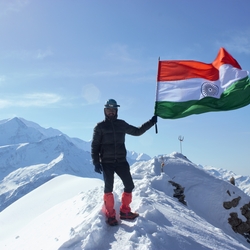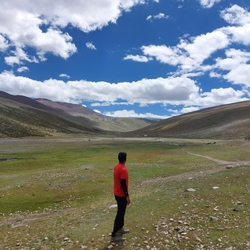Located in Uttarakhand, both Brahmatal and Kedarkantha are a beginner’s gateway to Himalayan trekking. Both the routes remain open through the winter months and are a great choice for winter adventures in the Himalayas. Panoramic views of snow mountains in the distance, starry nights and snow covered meadows make these treks unforgettable and are bound to leave an impression. They will leave you coming back for more as the mountains never disappoint. Given how much both the treks have to offer, it can be confusing if you only had to pick one. In this article, we aim to provide you with an overview of what both the treks offer and how they are different from each other.

While both Brahmatal and Kedarkantha give each other strong competition and level up in terms of captivating beauty, here is what is different on the trails!
Brahmatal or Kedarkantha?

Difficulty Level
Although both the treks are suitable for beginners, Kedarkantha is rated level 2 on the Bikat Rating Scale whereas Brahmatal is rated level 3. While there is little difference between these levels, your fitness could hold the key to your dilemma between these two treks. Both the treks involve camping in the mountains, chilly temperatures which can drop to sub zero in the winters and a fair amount of walking or trekking on varying gradients and topography. The Kedarkantha trek covers a distance of 23 km over 5 days which includes a summit climb to the top of Mt.Kedarkantha from where you get 360 degree views of Yamunotri and Gangotri ranges. The summit day can be challenging given the ascent to the top which starts at wee hours and can be accompanied by strong winds and biting cold temperatures.

Brahmatal, which requires a marginally higher level of fitness spans over 6 days and covers 35 km, taking you through the ridges and meadows of Garhwal Himalayas all the way to Brahmatal top. The trek to Brahmatal top can be challenging during snowfall with trekkers encountering knee deep snow as they make their way up. When compared to Kedarkantha, Brahmatal covers more distance and is a day longer although the terrain and conditions might be similar.
If you are confident of your fitness and would like to challenge yourself, Brahmatal is the perfect choice for your winter adventure. If you are a beginner and new to trekking, Kedarkantha would prove to be delightful as your first choice of trek, especially during the winters!

Peaks Visible
The Kedarkantha peak offers 360 degree views of Himalayan peaks such as Bandarpoonch, Black Peak, Swargarohini, and Ranglana, all of which are a part of the Gangotri and Yamunotri ranges. These views are a striking reminder of the grandiosity of these mountains and add a golden sunrise to the mix, it will make for one of the best sceneries in the world. Brahmatal top opens into panoramic views of Mt.Trishul, Mt.Nanda Ghunti, Mt.Chaukhamba, Mt.Neelkanth, Mt.Kamet and Mt.Hathi Ghoda. With most of these names forming references to Hindu mythology, there is almost something mystical about standing there and just admiring these peaks that stand at a distance, so close yet so far away.

Terrain
The terrain encountered on both Kedarkantha and Brahmatal is more or less the same. The treks start from small villages and wind into coniferous forests with well laid pathways. They open into sprawling bugyals with views of major Himalayan peaks and both the trails take us to lakes nestled within the mountains, not too far from our campsites. The trail of Brahmatal also takes us through exciting ridges with views of snowclad mountains that will keep your head turning to get one more glance. However, the summit to Kedarkantha peak covers a longer distance through moderate to steep ascents through snow. The route to Brahmatal top is shorter in comparison but is a steady ascent to the top.

Trekkers on the Trail
Kedarkantha has garnered a lot of popularity in recent years with trekkers thronging the route, especially during New Year’s Eve, to get a glimpse of the sun rising over the mountains as another year comes to an end and a new one begins. This has resulted in mushrooming of trekking organisations which take big batches of trekkers; the route is known to be extremely crowded during the winters. While Brahmatal has also grown as an accessible route to beginners and is more popular than ever, it still sees marginally lesser crowds when compared to Kedarkantha.

Flora and Fauna
Both Brahmatal and Kedarkantha offer rich flora and fauna, particularly in the forest patches. While Rhododendron and Oak are common on both trails, Chir Pine can be found on the Kedarkantha trail whereas Conifers, Cedar and Fir form the dense forests around Gujreni campsite on the Brahmatal trek. Black and Golden Eagles are a lucky find on the Kedarkantha trek while trekking from Juda-ka-Taal to Kedarkantha base camp. On the route to Brahmatal, the forests above Lohajung are home to a diverse species of birds. The Himalayan bird, Monal, is endemic to this region and the chances of spotting it are high. Bird lovers keep your binoculars handy!
The above are a few factors you might want to consider while choosing between Brahmatal and Kedarkantha. Both the treks are a magnificent journey into the mountains and also to their peaks, offering captivating views and marking the beginning of many more Himalayan treks to come! We hope this article helps you make a more informed choice based on your interests and should you wish to know more, our team is always available to help.






